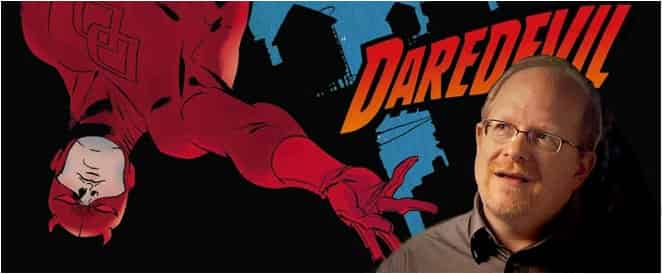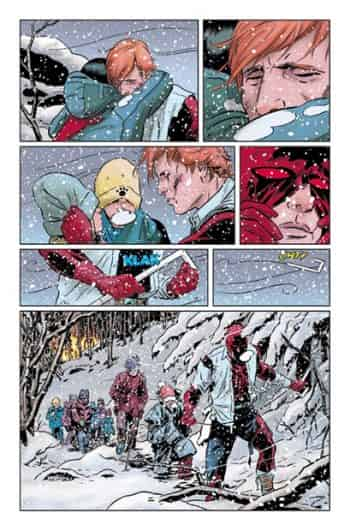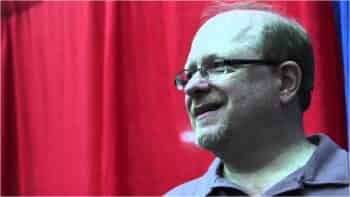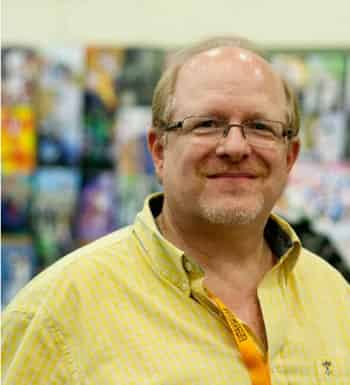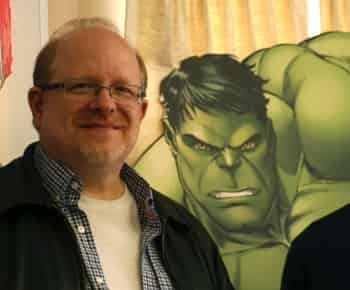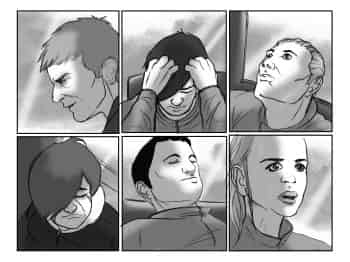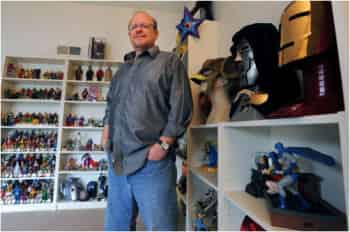
Mark Waid
The summit of Mark Waid’s art
Our admiration for Issue 7 of the Daredevil series, written by Mark Waid, is boundless. And Dylan Routledge feels the same: “I’d also love to give a special shout out to issue 7 that pops up in the second volume of Waid’s Daredevil run as it is simply not only one of the best single issue of his run, but potentially one of the best Daredevil issues ever AND one of the best single issues to have been published in the last five years.” Dylan Routledge, “The Weekly Challenge: Mark Waid,” http://www.comicbookdaily.com, October 12, 2015).
We would describe this story as Daredevil vs. the snowstorm. We consider it the peak of an orientation taken by a few writers to bring superheroes back down to human scale, in terms of the trials they face. This doesn’t mean that these challenges can’t be life-or-death, but they don’t need to have intergalactic implications.
For this post, we did some research to find reviews of Issue 7. Christine Hanefalk uses the word charm to describe it and adds, “Amazingly, the story never goes into too sweet territory.” (“Review of Daredevil #7,” http://www.theothermurdockpapers.com, December 22, 2011). Waid plays with clichés without ever stumbling. He draws from the character’s personality. “Mark Waid takes established elements, like the difficulty Daredevil’s radar sense has with a snow storm, and uses them to create a daunting set of obstacles for the characters to survive.” (Wed, “Review of Daredevil #7,” http://www.comicbookresources.com, December 21, 2011).
We naturally also found negative reviews—and even some very negative ones. We decided not to cite them here, not to censor an opinion—because interested readers can find them easily—and not to glorify the author either. We’re not doing a literary analysis of all of Waid’s work on Daredevil. Our goal here was just to express our admiration for him and for this issue, and the story developed in it.
Mark Waid’s era in the Daredevil series
“To me, this run isn’t just the best ‘Daredevil’ run of all time (and that’s saying a lot)—it’s also one of the best comics, ever,” said Christine Hanefalk (“In Your Face Jam: Thanks For Making Me Cry, Daredevil, “», http://www.comicbookresources.com, September 2, 2015). We wish we’d said it first. We’ve repeatedly praised Mark Waid’s writing style. He’s an author we discovered with the Daredevil series, and we still believe he was in perfect symbiosis with his subject, creating one of the most organic stories, one that avoided tons of typical comic book pitfalls.
To fully understand the life that Waid breathed into this character, we have to remember the basic material he had to work with: “For years, Daredevil had been one of Marvel’s grimmest comics. Recent years had seen Daredevil outed as Matt Murdock at the hands of the Kingpin, loved ones murdered or driven insane by various villains, a stint in prison, and even a brief possession by a demon. When Mark Waid and artist Paolo Rivera took over Daredevil in 2011, many wondered how the two creators would destroy Murdock’s life next. The answer: they’d make Daredevil happy.
“The creator’s Daredevil run marked a return to the fun, swashbuckling superhero adventures not seen in a Daredevil book since the Silver Age. Not only did Daredevil beat gangsters and supervillains without losing loved ones or suffering personal tragedy in the process, he did it with a smile, pursuing life with a newfound optimism and bravado. For months, Daredevil readers waited for the other shoe to drop, because this was a Daredevil series and Matt Murdock could only experience so much good in his life before the Kingpin showed up at his doorstep and beat him half to death. But the wins kept piling up for Daredevil and while Matt’s personal life was a mess, he wasn’t adding to his problems with his typical self-destructive behavior. For the first time in years, Daredevil was a “fun” comic, a relative rarity in a genre filled with serious and straightforward takes on superheroes.” (Christian Hoffer, “A Look Back at Waid and Samnee’s Daredevil and Its Importance to Modern Comics,” http://comicbook.com, September 12, 2015). Despite this shift, Christine Hanefalk recalls that Waid never claimed that Matt Murdock’s depression was resolved. It was always there, and the hero just had to learn to live with it instead of making it a focal point of the story. “Waid shows that superhero stories can still tell serious stories without being dark and brooding” (Dylan Routledge, “The Weekly Challenge: Mark Waid,” http://www.comicbookdaily.com, October 12, 2015).
Aside from this shift in the character (while still remaining fundamentally faithful to it), the concept used, the reconnection, the homage to the Silver Age, was done in a very modern way: “Waid himself also contributes to the nostalgic mood of Daredevil, particularly with his choice of focus and guest characters. As well as bringing back old foes like Stiltman or the Jester or the Spot, he makes a point to focus on characters and concepts that feel tied and rooted in the sixties. Hank Pym is a recurring guest star, with the “hip scientist” and ant motif that defined the character in his earliest appearances. Indeed, Pym provides a link to the classic Avengers universe, nostalgically observing how things have changed. It’s not like the old days of the Avengers where everyone’s a casual identicard call away.” (Darren, “Mark Waid, Chris Samnee, Paolo Rivera et al.’s Run on Daredevil (Vol. 3) (Review/Retrospective),” https://them0vieblog.com, April 24, 2014).
This approach wasn’t loved by everyone. No one can achieve universal approval. “Reading the book feels more like something from the early 1960s than something modernized…” Andrew Ardizzi, «Daredevil # 7», https://www.comicbookdaily.com, December 26, 2011).
As is surely clear, we don’t agree with this last comment. An homage to sixties’ style would have resulted in overwriting, it would have made the topic of the story clear and unambiguous. But Waid lets the story speak for itself, and lets readers interpret the characters’ motives for themselves. For us, this style of writing is something to learn from and is a constant source of inspiration.
The art of self-promotion
In previous posts, we discussed the DIY trend. We argued that it makes it possible to avoid paying middlemen whose value added is debatable. At the same time we admitted the limits of this formula. However, it is possible to excel in all aspects of a comicbook project.
Todd Allen says that the top quality needed in DIY is self-promotion. “It depends a little on what your profile is and how good a person is at promoting themselves” (“C2E2: Digital Comics: The Next Page,” www.comicsbeat.com, April 29, 2014). This isn’t as easy as it sounds. Mark Waid, who is involved in the Thrillbent project, a webcomic publication platform, has this to say:
There are four factors to selling anything: content, distribution, publicity, and marketing. We are great at content; we are good at distribution. Because of the limited amount of time in the day, however, marketing and publicity is where we fall down. That’s no fault of the people at Thrillbent behind the scenes; that’s on me – I don’t have as much time as I’d like to pound the drum and get people to swarm to our site. (“Interview: Mark Waid on the Inner Demons of Daredevil, Attitude Adjustment for the Hulk, and the Thrill of Digital Comics,” www.comicsbeat.com, February 10, 2014).
We’re not looking for excuses, but if promotion is hard for an established artist like Mark Waid, then it’s surely a major issue for us mere mortals.
Reacting to external events
Our admiration for Mark Waid knows no bounds. We like the analysis he gives his own work. In an interview, he said this sentence, which we find very important: “I love the new directions of your Marvel books. Both Bruce Banner and Matt Murdock have fresh “onwards and upwards” attitudes. They’re deciding to change, whereas most of the time superheroes are more reacting to external events.” Reacting to events. He gives an example:
I think you see very clearly in Daredevil that depression is inertia. What fuels depression is that sense of helplessness, that sense of not knowing what to do next, that image of sitting on a gargoyle in the rain on the rooftop, frozen by inaction. To me, Daredevil come to grips with that and is actively pushing past. I wrote a scene where he feels that paralysis that comes with depression and he pushes through it. He makes an active decision to move forward. Any movement is better than no movement at all. (“Interview: Mark Waid on the Inner Demons of Daredevil, Attitude Adjustment for the Hulk, and the Thrill of Digital Comics,” www.comicsbeat.com, February 10, 2014).
Similarly, Greg Rucka, in talking about his work on Batman and on the death of Sarah Essen, said that “this death has to mean something.” (Chris Sims, “Born in a World Of Tragedy: Greg Rucka Reflects on His Batman Work, Part One,” www.comicsalliance.com, September 17, 2014). And when we look at the title of the article this quote is taken from, we realize that characters can experience tragedies—events over which they have no control—but at the same time, these same events must have some significance.
Heroes must take their destiny in hand, and at the same time, can’t be indifferent to the tragedies they see around them. At the end of the story “Counteroffensive,” Benson and his team return to the Bunker. They had been close to twenty when they left, and now are just a half-dozen. Did they win or were they slaughtered? Jenny has lost her brother, Liane is traumatized by the brutality of combat, and Benson must bear the weight of his decisions. They need to think about and absorb the consequences of their actions and those of others. This reflection process must lead to the upcoming events. That’s how we see heroes controlling their destiny.
What’s a digital comic?
To answer this question, we again turn to the words of Mark Waid, who here explains what a digital comic is not:
Waid immediately jumped in, saying they aren’t cheap animation and that “motion comics are the devil’s tools.” His follow-up points demonstrated a thoughtful approach. He thinks that what makes comics is the reader’s ability to determine the pace of the story. The ability for the reader to fill in the voices and what happens in the gutters, using imagination, makes comics an immersive medium. (“C2E2: Digital Comics: The Next Page,” www. comicsbeat.com, April 29, 2014).
At the same time, some analysts say it’s harder to lose money with digital than with paper editions (Janelle Asselin, “The Economics of Digital Comics: Journalist And Educator Todd Allen On His Important New Book,” www.comicsalliance.com, July 15, 2014). We would qualify this statement a little. If you do everything from A to Z, we’ll grant that a digital comic book is cheaper to produce. But what shape will you give your digital version? If you just copy existing architecture, sure, you’ll save money. But competition in the digital world is stiff and works on two levels (in our view): 1) We feel the digital architecture must differentiate itself in various ways to take full advantage of the Internet’s potential. 2) The Internet requires a rate of posting that can capture and maintain the reader’s interest. Both of these demands require an investment.
Having something to say
As we’ve written previously, in the comic book world, authors often have grand concepts to justify re-launching a series (Josh Wilding, “Make Mine Marvel? No Thanks. Why DC is now the place to go for quality comics,” September 11, 2013, www.comicbookmovie.com/fansites). Anthony Falcone summarizes the situation thusly: “… in the majority of comic books a real story isn’t told but a series of things just happen and are put together in a slapdash fashion.” (Anthony Falcone, “Comics I Read Aren’t Sh*t,” January 31, 2013, www.comicbookdaily.com).
So, as we’ve also mentioned before, character deaths are often used as a simple dramatic springboard, without having any impact on the readers (Anthony Falcone, “Death be not proud ,” February 28, 2013, www.comicbookdaily.com), who simply count down until the character returns (Tony Guerrero, “Death and the Return of Characters: Jean Grey,” April 11, 2013, www.comicvine.com).
In her analysis of Daredevil, Christine is heading in the right direction: “the best superhero stories have at least something to say about some of our most human challenges.” (Christine, “Review of Daredevil # 26”, May 22, 2013, www.theothermurdockpapers.com). Heroes or superheroes can face superhuman challenges, but when faced with more down-to-earth challenges, how can their reactions be so different from the rest of us humans?
Along those lines, Chris Sims draws an interesting line between the Marvel and DC universes: “What it comes down to is that the Marvel universe is built on limitations. That’s the core difference between the foundation of the Marvel Universe and the DC Universe. Even though they’ve largely been shaped by the same creators over the past few decades, they’re built around very different ideas that are expressed in the characters that define them. There’s nothing that makes me roll my eyes harder than when people refer to the DC characters as “Gods” because that’s such a goofy, high school way to look at them, but even I’ll admit that there’s an element of truth to it. The DC Universe, even before there was a DC Universe, was built around characters that have this uncomplicated aspirational ideal to them. You just need to look at Superman to see it.” (Chris Sims, “Ask Chris # 171: The Superman (Well, Supermen) of the Marvel Universe,” November 15, 2013, comicsalliance.com). These “simple aspirations” are too simple, we guess: so let’s give our characters more elaborate desires and we may end up with denser stories.
Internet, format and action
Mark Waid introduces two interesting ideas that, in our opinion, become conflated. The first isn’t really new: “Remember: this is what media does. Radio up until the 1960s was two or three formats. Now it’s a million formats. Television? Same thing. Three channels becomes a hundred channels. Any medium eventually fragments out towards a wider base of people where each individual fragment does what it has to do to survive on its own. It doesn’t have to appeal to the wider base. In retrospect, it’s kind of amazing and surprising that something that’s been around for 75 years like print comics hasn’t sort of gone through that same dissolution. Instead it’s put all of its eggs into the one basket.” (“CR Holiday Interview # 22 – Mark Waid,” January 10, 2013, www.comicsreporter.com). This promotes the fragmentation of tastes, where a consumer can more easily find something that appeals to him or her. However it also makes for smaller markets, which then brings up the issue of profitability, or more concretely, of how to limit costs on these projects.
However, from a writing point of view, the story should be compatible with its publication format. And here is where Waid brings up his second point, a more original one: “That’s what you have Marc Guggenheim for. That’s what you have comics writer Marc Guggenheim slash lawyer Marc Guggenheim for. He’s on speed dial. I take the same approach that Stan and Gerry Conway and a lot of other guys who’ve written Daredevil in the past have taken, that is that you want to try to be very, very faithful to the law, but not to the point where it stifles your story. And you kind of have to give it some leeway. Especially nowadays, nobody wants twelve pages of Matt Murdock in a courtroom, because comics don’t do that well, television does it better and for free.” (Christine, “Mark Waid talks Daredevil at Baltimore Comic Con”, September 7, 2013, www.theothermurdockpapers.com). This would imply that some formats are better adapted, or more natural, for exploring certain themes or certain types of production. That’s certainly something to think about.
Taking time to retrace our steps
We were always annoyed about how some comic book authors always felt they had to take a page or two to summarize past events. When we first picked up a comic book, we fell into a story arc whose ramifications went back several issues. We adapted.
However, more recently we read an interview with Mark Waid, who said: “Every once in a while, you’ll get some criticism from a fan who goes, “Yeah, yeah. I know all about Mega Crime. Stop beating a dead horse.” And I’m thinking, “Look, it’s awesome you’ve been keeping up with the book, but have some mercy or compassion for somebody who might be picking it up for the very first time.” (Oliver Sava, “Mark Waid on his Personal Digital-Comics Revolution,” July 10, 2012, http://www.avclub.com)
This was something of a revelation for us and we decided to integrate a summary of the past ramifications of the story we’re currently developing. The question was how to present it. We didn’t just want a straightforward summary. In a discussion with one of our collaborators, we were reminded of the importance of our timeline, and we decided to make use of that. It lets us integrate four dimensions: a short summary, a few key drawings, and the timing of the events.
Work discipline
In an interview, Mark Waid admitted that he doesn’t have any work discipline nor a set pace of work. Some days may be dedicated to writing while others may be spent doing research online. We prefer to be more disciplined and to maintain a more steady work pace. Two constraints “force” us to write: first (naturally) are our own deadlines, and second is the identification of possible locations for the stories. For example, seeing these photos gave us the idea for the story “Tailspin.” On top of encouraging us to write, these two constraints help us better stage the stories we’re planning.
The size of the universe
In this interview with Mark Waid, he talks about the Daredevil universe: “In some ways he was a poor man’s Spider-Man in that they were trying to emulate the same sort of soap opera, but the problem that you have with Matt Murdock was that first off, the supporting cast was much smaller. Spidey had a huge supporting cast, and Matt had Foggy and his secretary Karen and that’s it.” (“Mark Waid: A Banner Year Part One,” December 18, 2012, http://www.comic-con.org/toucan/mark-waid-banner-year-part-one)
A smaller universe can curb dramatic potential by keeping the dynamics between characters static. We feel that most readers can absorb a richer universe: many TV series and movies have very large casts of characters: for instance, The Lord of the Rings, etc. The search tool on our website lesapatrides.com includes over 40 main and secondary characters, which gives us the latitude Waid alluded to.


